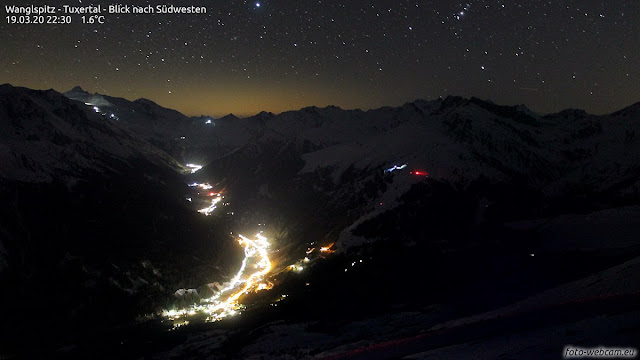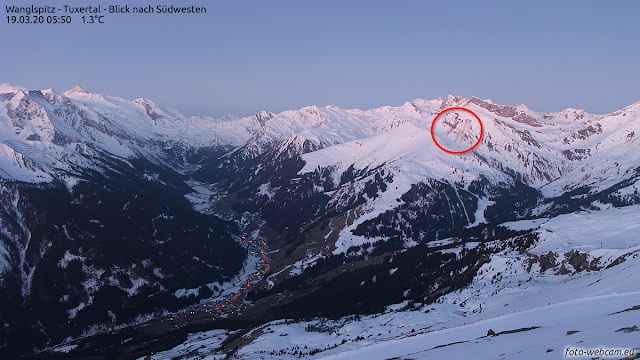The danger-level map of the EUREGIO Avalanche Bulletin for Friday 27.03 shows generally low avalanche danger. The situation was similar to that of last week, and it will remain that way over coming days according to weather forecasts of ZAMG Weather Service. As a result of some fresh snow starting in the evening of Saturday 28.03, fresh small snowdrifts at high altitudes and isolated glide-snow avalanches will be the major dangers.
 |
| Bildunterschrift hinzufügen |
Review of the last week
The information we have received from outlying terrain continues to be quite limited due to the edict of the governor of Tirol (Verordnung des Landeshauptmannes vom 20. März 2020 nach § 2 Z 2 des COVID-19-Maßnahmengesetzes ). Our evaluation of the situation is based primarily on knowledge we gained of snowpack layering before the curfew came into effect; on data coming in from our weather stations; on reports from various valleys; on simulations generated by avalanche models; and from our own empirical analysis linked to current weather conditions.
Cold and windy, very little precipitation
This verbal snapshot was last week’s weather in a nutshell. Before temperatures started to rise steadily starting on Saturday 21.03, some of Tirol’s first (and fairly impressive) thunderstorms of the year could be witnessed on the evening of 20 March.
 |
| Convective cloud build-up especially in northern regions led to frequently violent thunderstorms with short bouts of torrential downpour accompanied by thunder and lightning. |
At the time, on 20-21 March, huge amounts of precipitation were registered. Subsequently (on Sunday 22.03 and in the furthermost southern regions on 26.03) there was very little precipitation.
 |
| The situation in North Tirol closely resembles that of East Tirol. Highly unusual: the thawing point lies at -60°C - in indicator of extremely dry air. |
 |
| Up to 10 cm of fresh snow in East Tirol on 26.03. seen in the example above at Lucknerhaus. |
Extremely dry air masses in some places
The dry air referred to is a major factor during the run-up to spring as regards danger assessment. The snowpack on 23.03 remained firm all day long, despite intensive solar radiation, and developed corn snow if at all, then only slightly on extremely steep south-facing slopes. The snow didn’t melt, but rather sublimated, that is, slipped into a transitional phase from solid to gaseous form. During this situation the snowpack has immense amounts of energy drawn from it, which in turn slows down or halts the melting process. Add the low temperatures to that, and the melting process was brought more or less to a standstill.
 |
| During cold days and star-studded nights, water froze and often didn’t thaw during the daytime. Ötztal. (photo: 25.03.2020) |
“Penitent snow”
Aside from the positive effect which the dry air had by slowing down the wetness of the snowpack, there was also another interesting phenomenon which could be observed. Through the sublimation process, an unusual snow formation is generated with points rising from the surface, fondly known as “penitent snow” in folk culture. This form is frequently found over widespread areas in the Andes in South America.
 |
| Penitent snow in St. Sigmund in Sellraintal (photo: 24.03.2020) |
 |
| Close-up of the penitent snow (photo: 24.03.2020) |
Small snowdrifts at high altitudes
There were very few avalanche prone locations in the mountains last week. At high altitudes and in high alpine regions some snowdrifts were generated which, in the context of the overall situation, had no significance.
 |
| An aerial view reveals the snowdrifts generated in the respective aspects. View from Adlersruhe towards Grossglockner. (photo: 22.03.2020) |
Isolated glide-snow avalanches
Of note is a minor, highly isolated danger from potential glide-snow avalanches.
 |
| Glide-snow avalanche in the Gurgl Group. At upper left, a glide crack and the upturned snowpack are visible, i.e. a further glide-snow avalanche announcing itself. (photo: 22.03.2020) |
Outlook
As outlined above, conditions will be similar to last week’s. Potential minor problem zones stem from fresh snowdrifts at high altitudes and isolated glide-snow avalanches. In isolated cases the latter could be important to highly exposed sectors of roads.































































